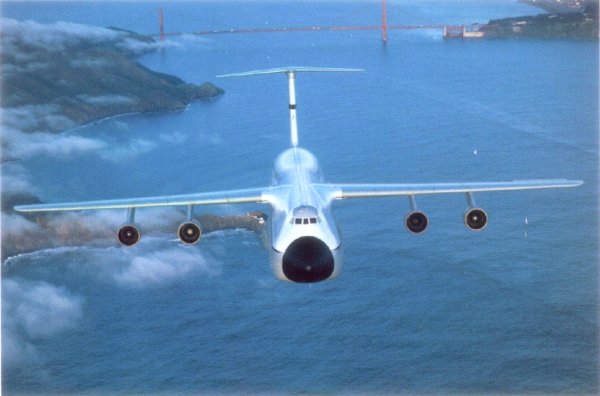
C-5 Galaxy
It's called "Fat Albert" and for a good reason -- it's almost as long as a football
field, as high as a six-story building and has a cargo compartment about the size of an eight-lane bowling alley.
Of course, it's the C-5 Galaxy.
The Air Force began to study very large logistic transports in 1963 to supplement the C-141 Starlifter and to increase
Military Air Transport Service's airlift capability.
This heavy logistics system was required to carry a payload of 125,000 pounds over a distance of 8,000 miles, or
twice that
load over a shorter distance. It also had to be able to operate from the same runway lengths and semi-prepared
runways as
the C-141.
The design competition was between Boeing, Douglas and Lockheed. Lockheed won in October 1965 with a design that
was
an extension of the company's Hercules/Starlifter series. With a gross weight of 764,500 pounds, Lockheed's Model
500
dwarfed not only other Air Force transports but every other type of aircraft operated by the Air Force.
To get an aircraft the size of the Galaxy off the ground would take a lot of thrust and General Electric developed
the TF39
turbofan engine. It was the largest such engine produced up to that time. Each engine -- the Galaxy has four --
develops
41,000 pounds of thrust. That's 164,000 pounds of thrust to get a fully loaded Fat Albert off the ground.
The <C>-<5><A> incorporated both nose and rear loading by way of an upward-hinged nose visor
and a ramp and
clamshell doors under the rear fuselage. Normal arrangement provided for 75 troop seats on an upper rear deck,
leaving the
entire lower deck clear for freight. In a pinch, another 270 troops could be carried in the main cabin. The Galaxy
could also
be refueled in the air, giving the aircraft unlimited range.
The first Galaxy flew June 30, 1968. The Air Force planned to purchase 115 of the giant aircraft to equip six squadrons.
The
first production contract was for 53 aircraft and the first aircraft was delivered to the Military Airlift Command's
Transitional Training Unit at Altus Air Force Base, Okla., Dec. 15, 1969. Two days later, the Galaxy entered operational
service with MAC and the 437th Military Airlift Wing at Charleston AFB, S.C. In December 1984, the 433rd Tactical
Airlift
Wing, now the 433rd Military Airlift Wing, at Kelly AFB, Texas, became the first Air Force Reserve wing to be equipped
with the Galaxy.
The Galaxy revolutionized aircraft loading. With its capability for drive-through loading and unloading of wheeled
and
tracked vehicles, loading is fast. The aircraft also has a "kneeling" landing gear system that lowers
the cargo floor to
truck-bed height. The entire cargo floor also has a roller system for rapid handling of palletized equipment. Thirty-six
fully
loaded pallets can be loaded in about 90 minutes.
The Galaxy's weight is distributed on a high flotation landing gear that has 28 wheels. A plus for maintainers,
the landing
gear system can raise each set of wheels individually for simplified tire changes or brake maintenance.
The forward upper deck of the C-5 has provisions for a crew of six, a relief crew of seven, and eight mail or message
couriers. The flight deck has work stations for the pilot, co-pilot, two flight engineers and two loadmasters.
The deck's
forward and rear compartments have lavatories, plus galleys for food preparation.
The C-5, with its massive payload capability, has pioneered unprecedented avenues in strategic airlift. It's been
involved in
many historic airlift missions: In December 1988, four Galaxies delivered 885,000 pounds of earthquake relief supplies
to
the then-Soviet Republic of Armenia. It was involved with the Alaskan oil spill cleanup in March 1989, hauling
almost 2
million pounds of cleanup equipment to Elmendorf AFB, Alaska.
The most dramatic display of the capability and value of the C-5 was during Desert Shield and Desert Storm. Along
with
other Air Force transport aircraft, the Galaxy airlifted almost 500,000 passengers and more than 577,000 tons of
cargo. This
included 15 air-transportable hospitals and more than 5,000 medical personnel. Each day, the Galaxy moved more
than 211
tons of mail to and from the men and women in the Middle East. (Courtesy of Air Education And Training Command
News
Service)